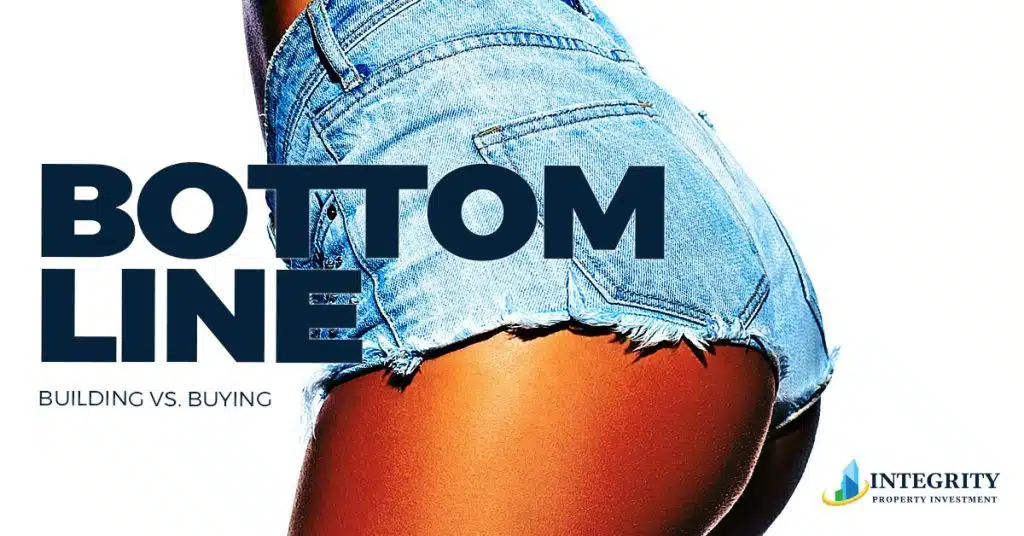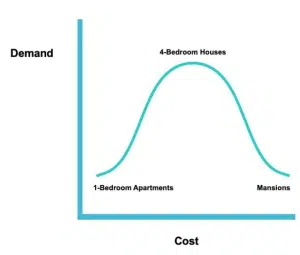The bell-shaped curve of property.
Understanding housing demand.
Let’s take a look at a bell-shaped curve when it comes to housing demand.
Bell-shaped curve of housing demand
The majority of demand for housing is in the middle of the curve. That’s where you find your four-bedroom family homes. At the low extremity, you’ve got the one-bedroom apartments or small flats and at the other extremity, you’ve got the mansions.
The most demand can be found in the middle of the curve. So if you have properties in the middle of the market, you’re always going to find someone to rent them. You’re always going to get the best, most stable returns. If you play around at either extremity, that’s where you’re more likely to run into problems.
Decision dilemma🤔 The choice between new and old properties
Remember the four big mistakes? Mistake #3 is buying an old property. The government is required to increase the housing stock to keep up with the growing population. As a result, all of the government incentives are geared towards newly built properties.
The main reason to buy new is for risk management. New properties come with a builder’s warranty and structural guarantee so you aren’t caught unaware and have repair costs at the start. If you are buying a second-hand home, you don’t know what you are getting. Consumer law is “buyer beware”. You can have a building and pest inspection done but there is still the risk that you could be buying a lemon.
New properties are also significantly better for cash flow. Older properties naturally cost more in maintenance. After 10 years, a typical house starts to need more maintenance. Once a house is 20 years old, you need to start budgeting about $5,000 per year in maintenance so you can give it a paint, replace the air conditioning, and so on as needed.
The other benefit of a new property is depreciation. Theoretically, a building will continually be going down in value. Not the land, but the structure. Think of things like your carpets and curtains that you won’t be able to take out and sell for the same price as what they cost to install. The government acknowledges this depreciation on investment properties and allows you to claim the theoretical depreciation on your tax.
A brand new house will get at least $20,000 depreciation and depending on which tax bracket you’re in, you’ll get about a third of that back. That’s about $7,000 a year in your tax return or about $134 per week. Once the property reaches about 20 years of age, the depreciation is negligible or completely finished. When we compare the two: the new house is giving you about $5,000 a year while the old one is giving you nothing. Most people who buy old houses don’t realise this and don’t know what they’re missing!
New properties are about $12,000 per year cheaper to hold (you’ll earn an extra $7,000 on your tax return and you won’t lose $5,000 for maintenance costs).
Historic charm vs. modern convenience. Build or buy an existing property?
The bottom line is that you should always buy brand new properties. The structural guarantee is a massive insurance policy for you. Depreciation is also a benefit of building a new property. With two sets of depreciation laws in Australia, the more generous laws favour brand new properties and are designed to encourage people to buy new or build properties. Building a brand new home also attracts the best tenants because who wouldn’t want to live in a brand new home?
Nine times out of ten, the only way to get a brand new property is to build it. That is, you have to buy a block of land and get a builder to build the house or buy off the plan with a 10% deposit as a part of a townhouse or apartment scheme. I see a lot of people trying to shortcut the process and they buy an existing home because they are not willing to go through the process of building. Those people are making a big mistake.
When you buy an existing home, you really don’t know what you’re buying, even after completing a building inspection. If you’ve ever read a building inspection report, you’ll have noticed that it’s about 25% information and 75% legal disclaimers because there is only so much a building inspector can do during their one-hour inspection. They, unfortunately, don’t have an x-ray machine, and they can’t see under the slab or behind the walls, so they don’t know for sure that the building is 100% structurally sound.
Do you think that there could be people who might have a house with structural problems and know full well how expensive those problems are to fix, conceal them and sell the property to someone else? Do you think that’s possible? Of course, it is! It’s unlikely but it is possible. If it happens to you, you will inherit a problem that could cost you hundreds of thousands of dollars. That’s why you should always buy brand new and 9/10 times you have to build to get a brand new property.
Come back where I’ll discuss land size.
~Daimien Patterson



